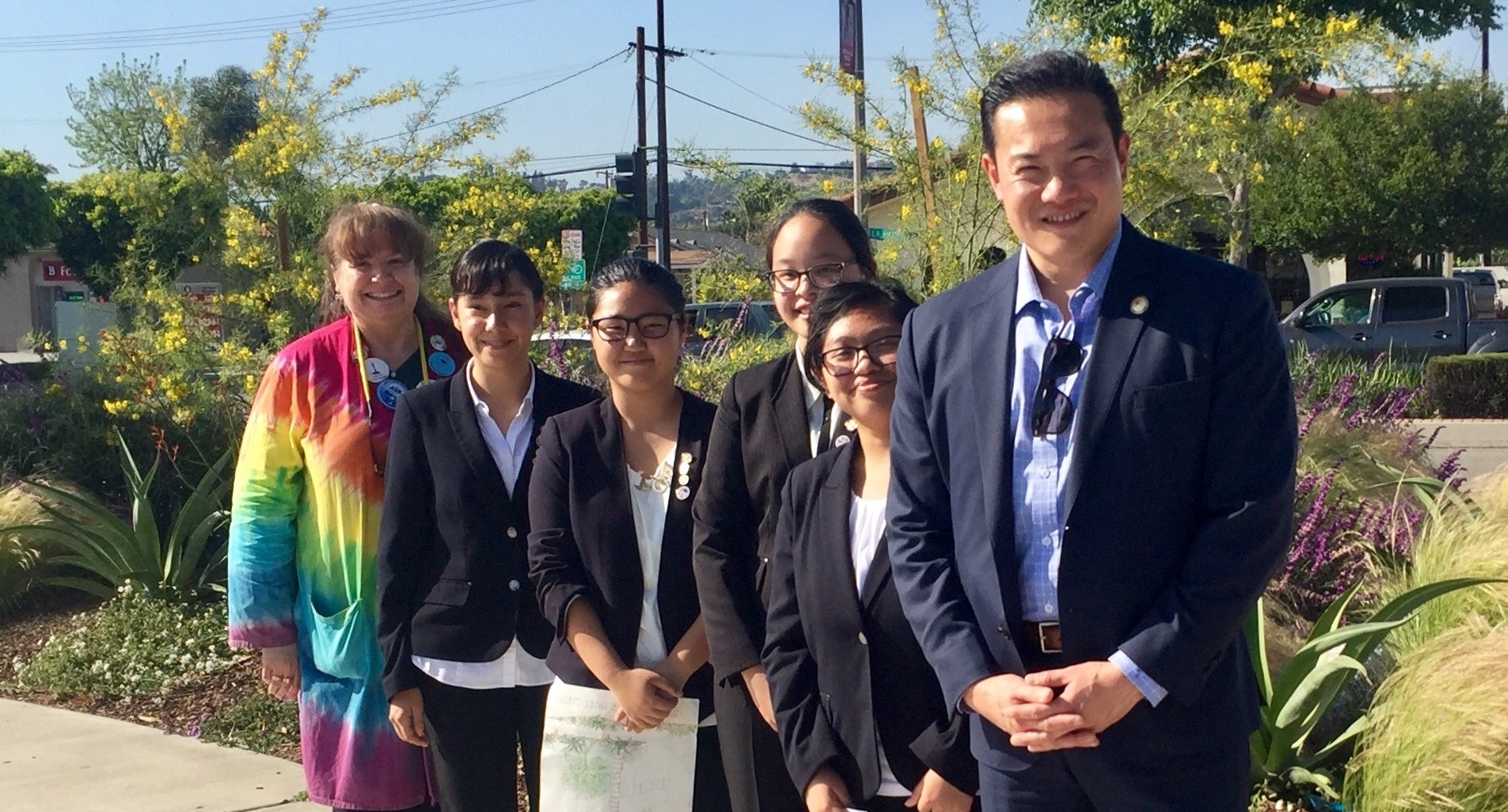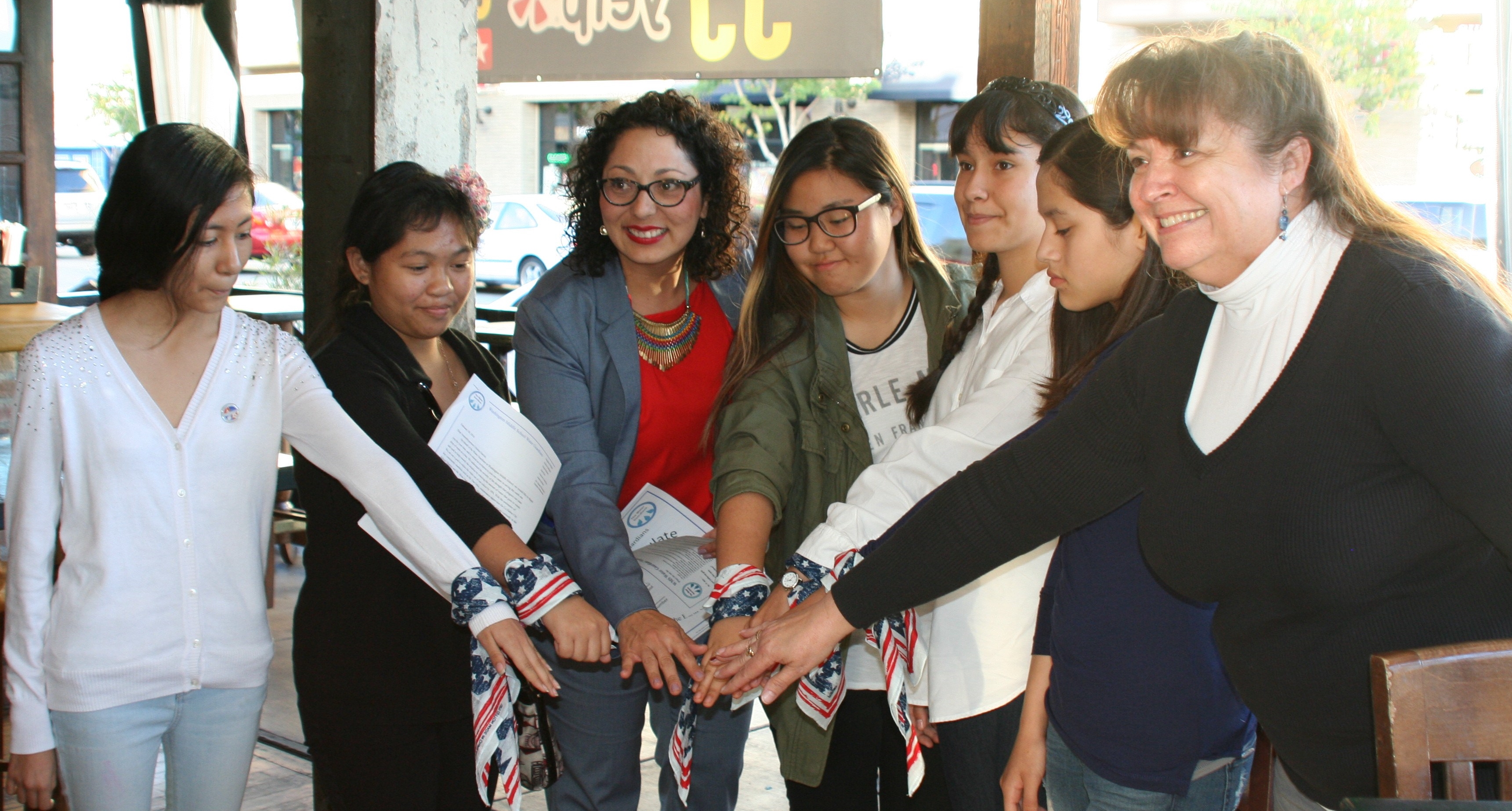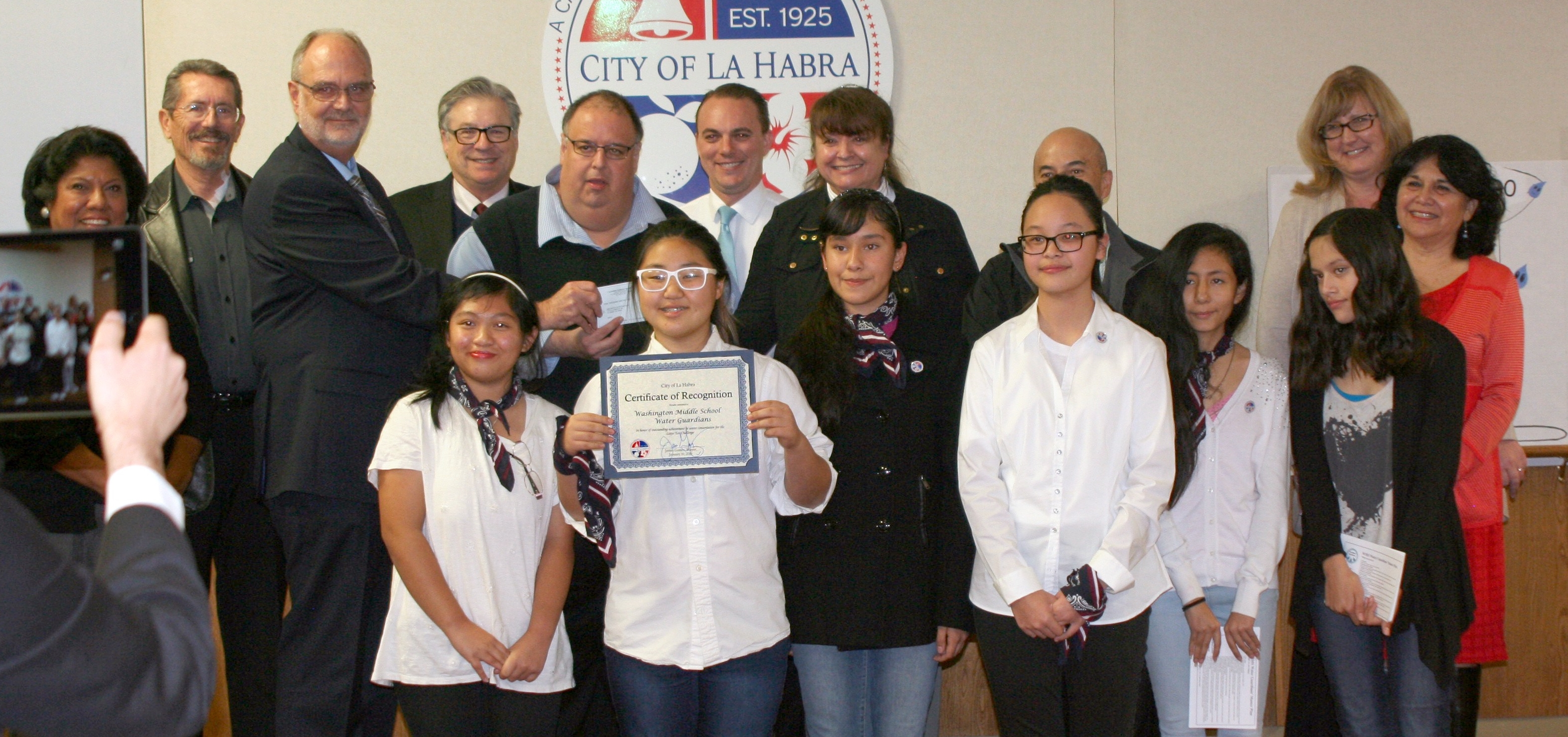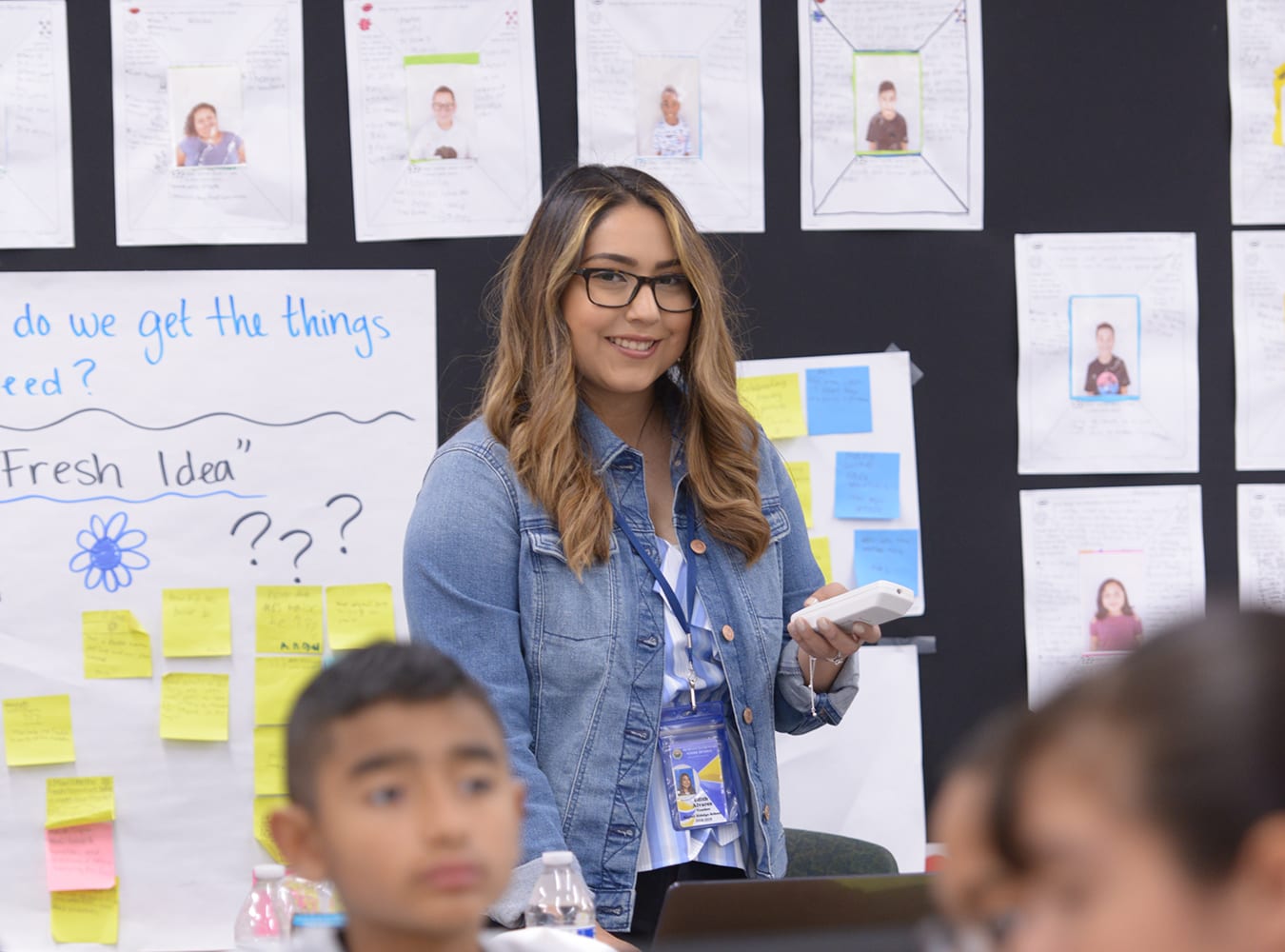
Educator and Water Guardians adviser Susan M. Pritchard, Jessica Gallegos, Skye Lim, Fiona Paredes, Angeline Dequit, and Assembly Member Phillip Chen.
Two years ago, six students from Washington Middle School in La Habra heeded my call to enter a national contest to identify an environmental issue and develop a plan to address it. This smart, all-female team named themselves the La Habra Water Guardians. They came up with a project to conserve water at our school. Under my guidance, they put in long hours of STEM-related research, experimenting and writing up their results after school and on weekends. They emerged victorious as first-place winners in the 2015-16 Lexus Eco Challenge, earning cash prizes for college.
Four of the original six Water Guardians carried the project even further, as they moved on to high school. Angeline Dequit, Jessica Gallegos, Skye Lim and Fiona Paredes, now sophomores, went on to propose legislation that expanded on their project. They just celebrated passage of Assembly Bill 1343, the Go Low Flow Water Conservation Partnership Bill, in July.
This came together because of their hard work and worthy cause — and because of networking and making connections. The Water Guardians’ experience, which continues today as they help implement their legislation, is a powerful lesson in learning, connecting and making an impact.
Reducing water usage in schools
AB 1343 aims to reduce water usage in schools and educate students about water conservation. It encourages collaboration between school districts and their water suppliers: Districts use the suppliers’ conservation expertise to develop curriculum for their students, and water companies give rebates to districts to replace high-flow devices with low-flow fixtures. Since nearly 67 percent of California’s K-12 schools have toilets using 5 gallons per flush, replacing these with low-flow versions alone will save the state over 20 million gallons of water — per day.
But before the legislation came to pass, the Water Guardians had to muster support for their middle school project, called the Water Conservation Master Plan. They met with key school and community members. They sponsored a water-themed school dance that raised more than $600 to help implement a campus drought-resistant garden, part of their plan. They met with the La Habra City School District board.

Vanessa Canchola, Dequit, Assembly Member Cristina Garcia, Lim, Gallegos, Alma Spicher and Pritchard.
We all began to realize that the plan had broader applications. At the end of 2015, the Water Guardians started to speak to various organizations, beginning with one-on-one meetings in my classroom lab. These meetings were inspired by my experiences as a teacher member of the California Council on Science and Technology’s California Teachers Advisory Council (CCST’s CalTAC).
“The team practiced often my long-learned adage: Take a ‘no’ and change it into a ‘maybe’ or a ‘yes’ through compromise.”
CalTAC, on which I served from 2007 to 2011, is all about making connections between the classroom and the world of public and education policy. The relationship I developed during that time with the office of then-Assembly Member Bob Huff and his director, Tim Shaw, enabled us to get the Water Guardians the attention they deserved.
The team met with Shaw and gave him a strong presentation, which led to many more. They began to write a legislative proposal that could work statewide. With the blessings of the school board and superintendent, they wowed the city council, the Rotary Club, the Lions Club, the Metropolitan Water District Water Quality Control Board, the Whittier League of Women Voters, Assembly Member Cristina Garcia and her FIGs (Fellows in Government Program students), and the Cal Poly Pomona School of Engineering.
The Water Guardians were honored by the city council, and local water company President Jim Byerrum contributed $5,000 to their plan. The Cal Poly students helped with water calculations for the proposal. The state Legislature presented the team with proclamations of recognition and achievement.
Lessons in getting a law passed
Despite these and other accolades, we were not able to make headway with the proposal. But the team practiced often my long-learned adage: Take a “no” and change it into a “maybe” or a “yes” through compromise.
In early 2017, I took a chance and wrote a heartfelt plea to Assembly Member Phillip Chen. I explained the Water Guardians’ passion and commitment, and asked for consideration to be made for their proposal.
Nearly a week passed, when I received an amazing email from his office stating that he and his staff were not only interested, but had researched the viability of the proposal with local water companies and had decided to put forth a placeholder bill prior to the February deadline for this
year’s legislative actions. I remember being beyond excited when I shared the news with the team.
“ The Water Guardians have blossomed into confident ambassadors of water conservation for our great state. I could not be prouder.”
Their work on the proposal went into high gear. Their energy level never diminished.

The Water Guardians are honored by La Habra City Council.
In April, Chen and one of his staff met in my classroom with the Water Guardians, two school board members, our superintendent and the school principal. The team shared their ambitions and family history with the legislator, and he did the same with them. I am privileged to have witnessed all parties’ grace and passion.
Chen agreed to support the proposal, and introduced the legislation in the Assembly. Jessica and Fiona testified before the Assembly Education Committee in Sacramento on behalf of the legislation. The bill also had to work its way through several other Assembly and Senate committees.
AB 1343 passed the Assembly on May 4, and the Senate on July 3. On July 21, AB 1343 was signed into law. To the best of our knowledge and research, this bill is the first ever in the history of California to be a K-12-proposed piece of legislation that is now a law.
It has been an incredible journey of learning, diligence, determination, humility and the power of team effort. The young girls I first worked with in 2015 have grown and matured into amazing young women. They have blossomed into confident ambassadors of water conservation for our great state. I could not be prouder.
What is the team doing now? Well, they have not yet gone to Disneyland, but they are hard at work creating curriculum for the After School Water Guardian Conservation Clubs they want to support in our local schools.
Susan M. Pritchard, La Habra Education Association, is a National Board Certified Teacher of science and engineering at Washington Middle School in La Habra.
To learn more about the Water Guardians, see drpstem.com.
A Winning Plan
In August 2015, Washington Middle School STEM teacher Susan M. Pritchard urged students in all her classes to consider entering the national Lexus Eco Challenge. Six took her up on it. Conscious of California’s ongoing drought, Vanessa Canchola, Angeline Dequit, Jessica Gallegos, Skye Lim, Fiona Paredes and Alma Spicher looked at the school’s water use and devised plans for drought-tolerant landscaping, drip irrigation, and watering two days instead of three. They also recommended getting low-flow toilets and automatic faucets.
The Water Guardians, as they named themselves, said these changes could reduce Washington’s water use by at least 30 percent.
With Pritchard as their adviser, the team also designed an “e-packet” — a tool to distribute educational ideas on water conservation — available online for international audiences. Their project won the Middle School First Place Prize in the 2015-16 Lexus Eco Challenge, which came with cash prizes for college.

The Discussion 0 comments Post a Comment